GUSTAF II ADOLF
THE THIRTY YEAR WAR
THE BATTLE OF BREITENFELDT
Paracelsus prediction had been dire...
"Germany would be torn by fire and
sword, brought to near destruction until there would arise from a distant northern land, a
golden beast who would save them."
The war for minds and souls had been raging
for ten destructive years when the vaunted, virtually undefeated imperial army of the
Hapsburg emperor and his allies looked across the gentle valley of Breitenfeld
directly into the blinding rays of the dawn of modern warfare. By the end of the day
Tillys lumbering army lay smashed beyond redemption, the victim of rapid firing artillery,
fastmoving infantry and hardcharging cavalry.
At dawn 7th of September 1631 the swedish army struck their tents at Wölkau and
marsched on Breitenfeldt. The imperial scouts knew of them and had informed the undefeated
commander, the 72 year old Tilly. The swedish units that marsched in the morning were the
life guards, The Dalregiments infantry under Åke Oxenstierna, Upplands and
Närke-Värmlands infantry under Axel Lillie, Östergötlands infantry under Erik Hand,
Västergötland and Dals infantry under Karl Hård, The finnish infantry under Klas
Hastfer, Johan Banérs german infantry, Niklas Chemnitz german squadron, Sigfrid von
Damitz (who didnt survive the day) with his german infantry, Adolf Theodor von
Efferen-Hall (who also was killed during the battle) with his german infantry, John
Hamiltons and Hepburns scots, Gisbrecht von Hogendorf with his red regiment of germans,
Mac Keys scots under Monroe, von Mitschefall with his germans, Robert Monro of Fowles with
his germans, scots under Alexander Ramsay, John Ruthwens regiment, Colonel Jacob Spens
scots under Jakob Lundsdaine, Maximilian Teuffel (who was to die) with his german
regiment, Thurns german regiment, colonel Waldsteins german regiment, Winkles and
Vitzthums german regiment. A sum of 14 742 infantrymen. The cavalry consisted of Klas
Dietrich von Sperreuter with the östgöta cavalry, Erik Soop with the västgöta cavalry,
Per Brahes smålands cavalry, Torsten Stålhandskes finnish squadrons, Juergen Aderkas
(killed that day) cavalry from Livland, Baudessins german cavalry, Caldenbachs german
cavalry, Damitz german cavalry, Dönhoffs squadron from Kurland, Efferen-Halls german
cavalry, Horns german cavalry, Kochtitzys german cavalry, Ordtenburgs german cavalry, the
rhinecounts german cavalry, Schaffmans german cavalry, Sperreuters german cavalry,
Taupadels german cavalry and Totts german cavalry. 12 heavy and 42 light regimental guns
made up the artillery. The saxon part of the army consisted of Von Arnims, Klitzings, the
princes, Läsers, Swalbachs and Starschedels infantryregiments of 12 100 men. the saxon
cavalry was made up by von Arnims life guards, Bindaufs regiment, the princes courtbanner,
the princes life guards on horse, Sachsen-Altenburgs regiment, Steinaus regiment, Lösers
noble horsemen and finally Pflugs regiment. The saxons also had 10-12 guns.

An imperial color with the insignia of the emperor. captured by the
swedish during the battle of Breitenfeldt. Now in the royal collection of war trophees.
The king Gustaf Adolf was the supreme commander. The swedish army had many more
officers which led to faster and more efficient actions by the units. The swedish advance
guard of 500 ran into superior imperial cavalry under the fiery cavalier Gottfrid Henrik
von Pappenheim at Krensitz. Gustaf immidietly send reinforcements and the imperials
withdrew. The king rode up to the hill the cavalry had captured and in his fieldglasses he
could see the imperial and leauguer army deployed at a favorable position on the other
side of the valley. The wind blew the dust into the eyes of the swedes and the imperials
had the sun in their backs when it rose. The swedish army stopped and food was
distributed. The soldiers were ordered to put green branches in their hats as recognition
signs. The battlecry of the day "God with us" was distributed. The enemy tried
to burn a bridge across a creek but swedish cavalry stopped them and took three standards
as well. The king deployed the army but had trouble because of the creek only had two
bridges over which to cross. The commander of the artillery, colonel Lennart Torstensson,
deployed the twelve heavy guns and the saxons followed suit. The regimental guns
only had an effective range of 300 meters and couldnt be used in this phase of the battle.
The saxons deployed to the left of the swedes. A two hour long artillery duel started.

Gustaf II Adolf
Jean Tsercleas Tilly was 72 years old and had never lost a battle. From his position
on the hill he observed the movements of the swedes and saxons. He was a fanatical
catholic and condidered the best commander there was. He commanded an army of veterans
used to victory. The battlecry of the day was "Jesus Maria". Tillys vitality and
charisma fueled his soldiers to the best of their ability. He had followed the career of
the swedsih king since he had landed in Germany the year before and probably felt an inner
satisfaction that he at last would get the opportunity to beat this noric upstart in a
battle. He awaited reinforcement but was going to attack nevertheless. Tillys victories
had been won by applying the spanish tactical school with heavy tercios and caracoling
cavalry. His cavalrymen wore heavy armor that covered their entire bodies. The heavy guns
would soon ravage the swedes. He remembered another nordic king that had been humiliated
some years before at Lutter am Barenberge, Kristian IV of Denmark.
The swedes moved to the right in an attempt to outflank the enemy. The front of the
swedish-saxon army was 4 km and when the swedes closed to 1000 meters the imperial heavy
guns opened up. The commander of the imperial left, von Pappenheim was rapidly losing
patience. Swedish guns brought down fire on his cavalry and he was ordered to wait.
Finally the impatient Pappenheim ordered an attack without authorization since his losses
mounted. His 5500 heavy cavalrymen moved towards the swedish right with its cavalrywing of
5000 men.
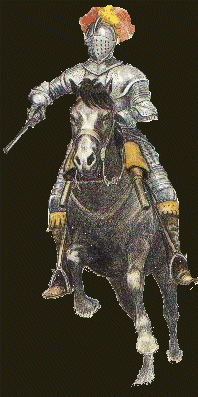
Imperial or leauguer Kurrassier heavy cavalryman
GUSTAFS ARMY
| Gustaf had developed a new army. With the ideas of Moritz of Orania
(actually Erik XIV was the first to think in this way) as a base he had developed new
tactics and new weaponry that produced the most effective army of its time. While Moritz
only started the development and used in ineffectively, only being succesful in sieges,
Gustaf perfected it and became one of the most influental and successful comanders of all
time. The pikemen recieved shorter and lighter pikes. 3 meters compared to the older 6
meters used by the enemies. They were stripped of their armor except a light harness and a
helmet. The enemy wore leg and armarmor as well as a shield. All in metal. The muskets
were made 2 kg lighter ( 5 kg compared to 7 kg) and were possible to reload and fire
without a fork. The effective rate of fire as three times that of the enemy. An attempt at
a standard calibre was made. The enemys muskets were so heavy that they had to be rested
on large forks and the reloadprocedure was made up of eighty counts. The swedish muskets
were considered revolutionary. They could be fired four times an hour! Accuracy was about
10% at 200 meters. The imperials later encountered in the 1630:s had many cavalryunits
known as currassiers. They were still clad in iron armor as the knights of the late dark
ages and the renaiccance. Their armor weighed about 70 kg. The swedish cavalry had a
harness, at the most! The artillery had been dominated by very heavy guns often at 1500 kg
that once depoyed before the battle were static. Thus often falling into the enemys hands
if the battle was lost. The swedish army supplemented these heavy guns with lighter pieces
(150 kg) regimental guns that were (for its time) mobile and could follow the advancing
infantry it was designed to support. Loaded with cannister, ball or grapeshot they had
horredous potential, achieving much higher rate of fire than the musketereers. The
tactical formation were altered as well. The Tercios of the spanish tactical
school were abolished. The tercio was a huge square formation with the pikemen in the core
and the musketers forming an outer brim of the square. Containing several thousand men (
1580 a tercio numbered 3000 men while in 1630 it had only 1200 men) it was a slow
lumbering giant with low firepower since only 25% of the musketers faced the enemy at a
given opportunity. The strength was in the pure offensive weight in a melee situation. Of
course a single tercio cant be outflanked as well. The pikemen were passive
targets whatever happened except for that they sometimes lowered their pikes to form a
fence around the musketeers. |
Tactic also made little use of the melee, drawn out firefights were the
pikemen were a waste was the common method. The tercio was very vulnarable to artillery
firing ball since it was packed so very deep giving the bouncing cannon ball a huge target
and the opportunity to maim scores of men standing in the deep squareformation. Gustafs
infantry instead used linear formations. These were much more mobile by the quick change
from line to column by ordering right or left face. The offensive firepower was greater
since 100% of the musketers could fire at the same target. The drawback was the
possibility of being flanked and the lack of sufficient men in a melee situation since the
stretched line lacked weight at the point of contact with the tercio. The swedsih
musketeers were also taught to fire in salvos. All at the same time rather than
individually. While the enemys musketers kept a steady stream of fire the swedish
unleashed sudden storms of fire at the enemy greatly magnifying the psychological effect.
Coupled to the higher rate of fire this was decisive. The crushing effect was used by
charging with the pikemen after the salvo with their shorter more maneuvrable pikes and
swords. Coupled to the regimental guns it was a good example of cooperatíon between the
different functions to achieve maximum effect. It brought back the offensive element to
the infantry that the tercios lacked. Since the late dark ages warfare in western
europe had been dominated by sieges and battleshad been shunned to the extreme end of it.
This was due to the tactic used and the lack of offensive action with the tercios.
While the enemys cavalry (except the polish) used the caracolle, the swedish cavalry
favored the shock effect of the charge. The caracolle centered on the pistol. In formation
of several lines the cavalry rode up to the enemy within effective range of the pistol
(about 10 meters) and fired their pistols. After that they rode to the side and back to
the rear of the formation reloading their pistols while the next line repeated the
maneuver. The name caracolle has a resamblence to carousel for that very reason. This was
highly inneffective since the lethality of the pistol was low. The swedes instead advanced
on the trot firing their pistols and then charged at full speed with drawn swords into the
caracolling enemy disrupting all of their finely tuned timing. The cavalry was supported
by units of musketeers making them much stronger defensively since the caracolling enemy
came into the effective range of muskets firing salvos followed by a fierce charge by the
cavalry. The supporting musketeer units lowered the tactical speed of the cavalry however. |

Imperial or leauguer Kurrassier heavy cavalryman
The musketeerdetachments supporting the swedish cavalry squadrons came as a complete
surprise to Pappenheim. The rapid salvo of muskets followed by the pistolfire and the
immidiete countercharge of the cavalry threw the imperials back in disorder after a
furious melee. The delicate coordination and timing of the caracole being disrupted by the
charge of the swift swedes and finns. Pappenheim didnt yield. He tried again. And again.
After a while he tried to outflank the swedes that simply wheeled their linear formation
to meet the new threat. After seven furious but futile attacks the imperials withdrew. The
first phase of the battle had passed.
Around half past two the next imperial move came. The twelve heavy and slow tercios
started to move. Flanked by cavalry they moved towards the swedish left. Horn saw the
coming but suddenly the enemy changed his direction. They moved towards the saxon
deployment to the left of the swedish left flank. The imperial commander Furstenberg
attacked the saxon center with 3000 cavalrymen and 1200 infantrymen. The saxons had 12000
men infantry and Bindaufs cavalry of 2500. But the sight of the well disciplined imperials
charging ahead made the saxons loose their nerve. They fired a volley at extreme range and
ran. The saxon artillerymen fought well however and von Furstenberg only captured two
guns. The saxon regiments Sachsen-Altenburg and Bindauf also resisted. The saxon cavalry
was routed however. The saxon commander Hans Rudolf von Bindauf was shot by the imperial
colonel Adam Philip von Cronberg himself.

Jean Czercleas Tilly
At half past three the twelve tercios of Tilly were closing in with the
saxon infantry. These didnt wait. They ran immidietly. Their prince tried to stop them but
failing instead joined them. Since their line of retreat crossed the swedish wagontrain
this was drawn into the retreat, or rather rout. The saxon artillery was without
infantrysupport and with most of their officers shot they ran as well. Left of the saxon
army was only the regiments of colonel Taube and von Arnim. These moved to the right and
joined the swedish left under Horn.
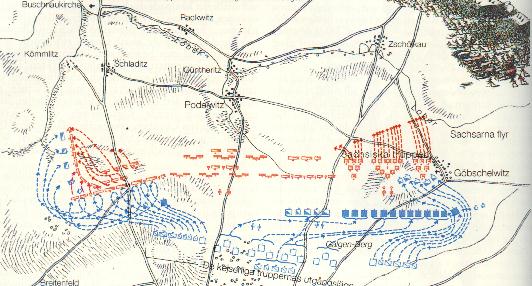
The blue forces are the imperials. To the left Pappenheims attack to
the swedish right can be seen as well as his failed atempts to outflank the swedes. To the
right the advance on the saxons and the rout of these is visible as well. The forces to
the left of the saxons are the two lines of Horn and in the center of the swedish line the
two lines are visible. The second of these later wheels to the right to reinforce Horn
when he faces the imperials on the swedish left.
The left of Tillys attack came in contact with Horns forces but were repulsed. The
enemy withdrew and joined the attack on the saxons. When the saxons ran Gustaf had lost
40% of his forces. On his left flank he didnt have a strong ally anymore but rather the
experienced enemy, turning the saxon guns on the swedes. The catholics were convinced that
the battle was won and started to turn their huge square formations of pikes against the
open swedish left flank while the cavalry still bounced against each other on the swedish
right flank. While performing the complicated wheel left maneuver with the huge tercios.
The regiments of Wahl, Comargo-Rheinach, Pappenheim and Wangler became separated from the
rest in the dust and didnt join battle again. Wangler later wrote that they had thought
the battle won and since they didnt see anything they waited for orders. But the rest was
still an impressive force. 18000 men infantry and 5000 cavalry advanced on Horns 3500 men.
Horns wife Christina had died in the plague only a month before. What was he to do? Where
was the king? While waiting for orders he wheeled his line to the left to face the
advancing enemy.
The king had been reached by the reports of the saxon rout while participating in
the fighting on the right flank. He immidietly rode to the left. He had sent Teuffel to
get information for him but Teuffel had been killed and the information had been delivered
by von Arnim. The king first encountered Caldenbachs cavalry that was in contact with
catholic infantry that had turned two saxon guns on them. The king initiated an attack and
the rode on. Horn must be reinforced. Gustaf ordered units from the second line to move up
to Horn. Hepburne and Vitzthums brigades were to attack the enemy to the left of Horn with
all the energy they could muster. Further reinforcements were taken from the only lightly
engaged first line. 3 regiments of musketeers and some regimental guns were sent to Horn.
The king rode back to the right flank to check on the development there.
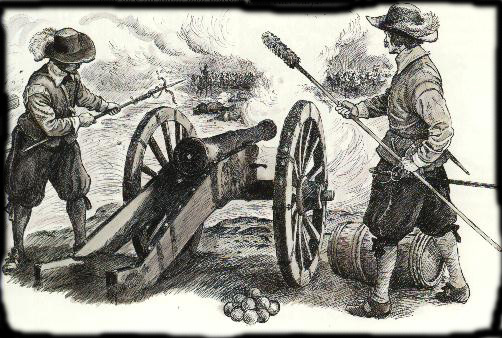
A regimental gun fires on the advancing imperials and leauguers.
Having recieved these reinforcements Horn decided to attack. While still being
numerically inferior to the enemy the linear formation allowed him to outflank the
cumbersome tercios on both flanks. Especially since their immobility meant that
they were still not finished with their redeployment. The musketeers fired a salvo
followed by a cavalrycharge followed by a volley followed by a charge. The light artillery
was used in a similar way. The swedish musketeers stood three lines deep. The first
kneeling, the second crouching and the third standing. All fired at the same time. Using
this technique a musketeer could fire a staggering 24 rounds an hour. An officer wrote
that he had his 3 guns fire, then his musketeers waited until at pistol range. After that
they charged with musket butt and sword. Lieutenantcolonel Monro tells that the green
brigade attacked by firing the regimental guns twice, followed by a musket salvo and the a
charge by the pikemen with their short (3 meters) more manuverable pikes levelled. The
catholic center was paralyzed. Their infantrymen couldnt use their weapons effectively at
this range while disrupted by the enemys salvofire. Their losses were staggering when the
rapid firing regimental guns balls smacked into the tightly packed tercios. The
men fell in rows as the bouncing brutalities tore gaps in the defenseless rear parts of
the tercios.The imperial caracoletrained cavalry coulnt defend themselves against
the hardcharging swedish cavalry and routed, leaving the infantry to die. Tilly was in the
middle of the turmoil, wounded and close to capture but saved by Maximilian, the duke
Sachsen-Lauenburg. His sortie must have been bitter.

The imperials start to rout.
The catholic infantry continued to fight however. At that moment the västgöta
cavalry entered action. On the small but strong horses sat peasantboys like Nils from
Eggvena, Olaf Pedersson from Tokatorp, Olof Andersson from Remmene and Jakob Pedersson
from Föllene village. They had come a long way from the soils of Västergötland to take
part in this dangerous adventure. At that time the catholics broke. It became every man
for themselves. A rout started but since they were almost surrounded by the enemy and
without cavalry almost all were killed by the furious swedes. Monro tells that the dust
was so dense that enemy could not be identified from friend and that he had the scottish
recognition signal beat on the drums to gather his men. By six in the afternoon it was
over.
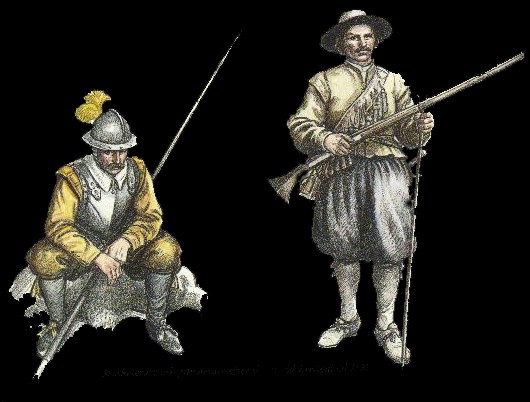
A swedish pikeman and a swedish musketeer.
But not entirely. The king had ridden to the right flank under Johan Banér where
Pappenheim refused to surrender. His offensive spirit had diminished however. The swedes
counterattacked the enemy that after the first clash routed and left two cavalryregiments
and the infantryregiment Holstein to continue alone. Banér attacked with
musketeercompanies and the cavalryregiment Ortenburg. The remaining enemy was disrupted
and scattered. The agressive Pappenheim is said to have killed 14 opponenets himself in
these clashes. The king now leads the right flank towards the imperial heavy guns that
still bombard the swedes. These were captured and the cavalry of the Rhinecount
distinguished themselves in that action. Since Horn had pursued the routing enemy the two
swedish flanks connected and together they engaged the last remnants of Tillys army. At
Linkewald the regiments of Blankhart, Chiesa, Goéss and Baldiron-Dietrichstein put up a
fierce fight almost to the last man. At seven o clock the darkness fell on the field of
battle.
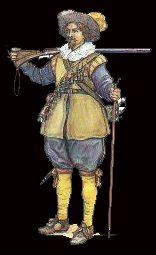
Swedish musketeer
Horn and Gustaf met on the road by Duben. Despite the darkness the king ordered the
cavalry to pursue the fleeing remnants of the beaten enemy. The wounded were either
gathered to the surgeons, that often could do no more than stab them to take them out of
their misery, or killed where they lay. The dead and wounded were looted for their clothes
and other valuables. Since the wagontrain had run with the saxons the swedes made do with
what the field offered for the night. The enemys pikes and wagons were used for firewood.

Color of the Tilly life regiment. The jesuits insignia IHS on white.
Captured during the battle.
Tilly had lost seven thousand killed and six thousand wounded. Of those who escaped
five thousand were killed by the saxon peasants in ambushes when they tried to get away in
small groups. The swedes lost 2100 in killed and wounded while the saxons lost 2000. The
swedes captured the entire artillery as well as the wartreasury and over 120 colors, among
them the command standard of Tilly. Discipline was still rigid. A swedish cavalrycaptain
let his men plunder a village and kill twelve villagers. The king killed some of the
offenders himself and had the captain hanged. The village was well compensated with money.
The battle was over. The enemy destroyed and the emperors dreams of a catholic state
from the mediterrainian to the baltic are crushed. From constant victory to utter defeat.
Had god turned lutheran?
The 36 year old king had in one blow achieved all that he set out to accomplish. He
could sue for peace, send his soldiers home to their farms to breed children and
grandchildren for whom they could tell the story of the glorious adventure thay had had
with the king. The hired regiments could be disbanded and he could have gone home for the
biggest victory celebration in swedish history. Mecklenburg and Pommerania would certainly
have become swedish as well as important coastal towns. The historians would have written
hundreds of books over the centurys debating the big question: what if Gustaf hadnt
settled? What if he had gone for the big win? Wasnt a grand opportunity lost?
It didnt happen. The children and grandchildren would never be born and the soldiers
would end either on the dirty field with glassy eyes and their intestines out in the open
or in a plagueinfested dirty garrison coughing their lungs out waiting for certain fevery
death. The war would drag on for yet 17 horrible years dragging Germany into utter
disaster and taxing Swedens recources to the utmost.
Instead of well needed peace a new even more dramatic era in swedish and european
history commences. Why?











